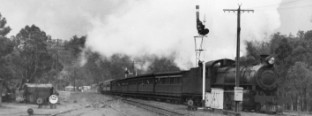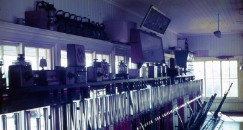Whatley
Quick Facts | |
Opened | Closed |
16/05/1903 | 16/04/1954 |
Mechanical | Electrical |
6 Levers | ? |
Fate: Unknown | |
On Saturday next, 16th May, 1903, at 9 a.m. the following signals will be brought into use:-
The levers working these signals are fixed at the 17-Mile Block Cabin.
The normal position of these signals when the block is cut out will be “all clear,” and the levers must then be locked in the pulled-over position.
The confusing nature of the names was finally sorted out in 1914 and was announced in Weekly Notice No. 8 of 1914 when it was proclaimed that in future, the present 17-Mile Main Line Signal Box will be known and distinguished by the name "Bassendean," and the 17-Mile Belmont Branch Signal Box as "Whatley."
This Signal Box is switched in when required.
Up and Down Starters, Home and Distant Signals, are provided. The position of these signals when the Signal Box is closed will be "All Clear," the levers will be locked in that position. The key of this Signal Box is in the possession of the Station-master at Bayswater, from whom it must be obtained, and to whom it must be returned when the Signal Box has been closed.
There is no Siding accommodation, and Cross-over roads are not provided.
On days when there is no one in charge of Belmont Signal Box, trains may be worked forward from Bayswater Junction under "Caution," but not more than one train must be allowed on the Branch at the same time (except by special authority of the Chief Traffic Manager); and Engine-drivers on returning on "Up" Line must approach the junction with extreme caution, as a Main Line train may be approaching from Guildford.
Any additional information on this signal cabin would be most welcome - please use the e-mail form provided on this page.
Information researched and interpreted by Chris. J. E. French of SignallingWA
Photograph by Pendon Museum courtesy of RHWA Archives and Diagram of Signalling by W. A. G. R. photographed by Justin Smith.
This page is copyright, and permission must be sought from SignallingWA before this page is used for any purpose other than personal education.
[Buy this page] or [View your SignallingWA ShoppingCart]
WHATLEY Employees | ||
This list may not be complete and does not yet include employees who worked here without being appointed. Where an appointment date is unknown, the Weekly Notice (WN) date advising of the appointment or other official documentation, i.e. Certificate of Competency (CC) will be used. | ||
Name | Appointed | Position |
Is a name missing? Please submit any corrections / additions with suitable evidence using the e-mail form above. | ||


